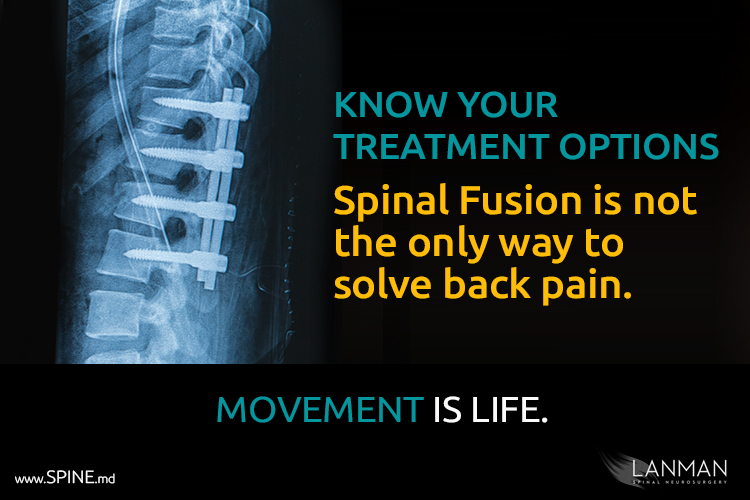Revision strategies for patients with prior cervical fusion
Spinal fusion has a long history. The procedure itself was developed over time from the early 1900s as a means of limiting spinal deformity caused by infections of tuberculosis. It was actually a coincidence that surgeons later realized that the procedure was also useful for patients who suffered from chronic pain in the lower back (lumbar) region.
Throughout the 20th century, fusion became the procedure of choice by surgeons with patients who were suffering from pain caused by degenerative disc disease. The procedure gave patients relief from various causes of pain and was the best that medicine could offer. However, spinal fusion had a hefty price for patients: loss of spinal flexibility and gradual loss of natural mobility.
It is from that loss of flexibility and mobility that I consider fusion surgery the “brute force” against back and neck pain. The one thing that spinal fusion does very well is to immobilize the flexible joint level between two vertebrae. In doing so, the procedure often creates new problems by increasing the stress on adjacent levels. As a result, there is a greater likelihood for additional fusions. In my work as an attending neurosurgeon at Cedar-Sinai Medical Center in Los Angeles and of my own spinal neurosurgical practice in Beverly Hills, I’ve seen many patients who start with single-level fusions, and end up with two and three-level fusions.
Sometime during the 1980s, surgeons in Europe who sought better patient outcomes in the treatment of degenerative disc disease came up with the idea of replacing ruptured discs with artificial ones. Physicians in the U.S. began studying the procedure in 2000. Artificial disc replacement (ADR) received FDA approval about seven years later. I was part of the clinical studies that helped bring that outcome to fruition. I also led recent clinical studies that put artificial disc replacement within reach of all patients who suffer from back and neck pain.
The bottom line from these recent studies: artificial disc replacement produced significantly better results over spinal fusion. The statistical data from the survey showed that ADR patients had better outcomes than patients who underwent fusion. Not only did the artificial discs help them preserve natural movement, but they also experienced fewer complications, required fewer corrective surgeries, and their pain was diminished or nonexistent. Now we’ve entering a new phase where artificial disc replacement is literally replacing spinal fusions.
I have a patient, a younger gentleman who came in with pain complaints from a previous neck fusion. I ordered CAT scans for him and found that the bone graft did not fuse the vertebrae correctly. Add to his problems, the screws that held the fusion plate were loosening. Not surprising, he had severe neck pain and arm pain.
Being as young as he is, I would have never recommended fusion in the first place. Nevertheless, his first and primary desire was to get rid of the fusion and replace it with an artificial disk, which we went on to perform. My only caution in these cases is that this is a hybrid procedure and considered “off-label” for the artificial disc under present guidelines. In other words, the FDA has not evaluated specific studies for this type of procedure. However, the FDA does not regulate how a physician chooses to use an FDA approved device. If the doctor feels that a hybrid approach is in the patient’s best interest, the doctor is free to operate. All that is required is that the patient is fully informed ahead of time.
In the case of this patient, he is doing beautifully with zero pain and even returned to work only three weeks after surgery. The best part of this story is that my patient is healthier and he has regained full painless movement of his spine. It is stories like these that really inspire me to continue this work.
I admit some level of frustration when I meet a relatively young patient who has endured this kind of medical result. I’m astonished that the medical community has not evolved. Spinal fusion is a procedure from a previous century. It had its day. It’s now time to turn the page to new technology.
I will be compiling additional clinical studies for publication. More data will be published in medical journals after it is thoroughly assessed and statistically analyzed. However, the further clinical study will not change the fact that artificial discs exist, the procedure is medically sound, and the practice is growing at many hospitals and private practices all over the country. More significant, artificial disc replacement surgery is now successfully used as a revision alternative for patients who have had prior fusions.
One last note, artificial discs have one great advantage over fusion -the devices themselves can last at least 70 years. Most ADR surgeries do not need to be revised in 7 to 10 years as do spinal fusions, or in 15 years like total knee replacements, or in 25 years for hip replacements. Once the discs are in place, the device will usually remain for the rest of the patient’s life. If indeed a patient develops a problem with the device, it can be removed and replaced with a new artificial disc without requiring the patient to endure the complications and additional risks that fusions pose.
The work on artificial discs and surgical methodology is advancing and patients are preserving motion, mobility, and function. More and more patients are like the young man in this story – they are greater than better.
###





